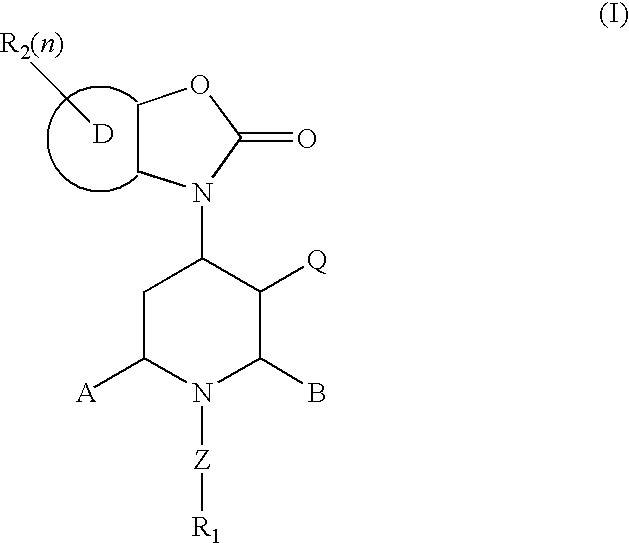Nociceptin analogs
a technology of nociceptin and analogs, applied in the field of nociceptin analogs, can solve the problems of untold amount of suffering, and achieve the effect of sufficient time for metabolism
- Summary
- Abstract
- Description
- Claims
- Application Information
AI Technical Summary
Benefits of technology
Problems solved by technology
Method used
Image
Examples
example 1
Synthesis of Benzoxazolone Head Groups
The head groups of the present invention were synthesized according to the following procedure:
Procedure:
To a mixture of 1 (1.09 g, 10 mmol), 2 (1.99 g, 10 mmol) and acetic acid (0.60 g, 10 mmol) in 50 mL of dichloroethane, was added sodium triacetoxyborohydride (2.97 g, 14 mmol). The mixture was stirred at room temperature overnight. The mixture was filtered through Celite and 1 N NaOH (50 mL) was added to quench the reaction. The organic layer was separated and the aqueous layer was extracted with EtOAc (2×30 mL). The combined organic layers were dried over K2CO3, filtered and evaporated in vacuum to give crude 3 as a brown solid (2.75 g, yield: 94%).
1H NMR (CDCl3): d 1.20-1.60 (m, 11H), 2,00 (dd, 2H), 2.9 (m, 2H), 3.40 (m, 1H), 4.00 (m, 2H), 6.60-6.85 (m, 4H).
To an ice cooled solution of crude 3 (12.0 g, 40 mmol) and DIEA (20.8 mL, 120 mmol) in 200 mL of THF, was added a solution of triphosgene (4.32 g, 14.4 mmol) in 200 mL of THF. After the...
example 2
Attachment of Tail Groups
Tail groups were attached to the head groups according to the following procedures:
General Procedure for Alkylation:
To a solution of the amine (1 eq) and triethylamine (1 eq) in dimethylformamide, was added 1 eq of alkyl bromide or chloride in one portion. The mixture was stirred and heated at 80° C. over night. TLC indicated the reaction was complete. The reaction was quenched by the addition of water followed by 1 N NaOH to pH 10. The mixture was extracted 2× with Et2O. The combined organic extracts were dried over potassium carbonate and the solvent evaporated, followed by chromatography to give the pure product.
General Procedure for Reductive Amination:
To a mixture of ketone or aldehyde (1 eq), amine (1 eq), and acetic acid (1 eq) in methanol, was added sodium cyanoborohydride (1.4 eq) in one portion. The mixture was stirred over night at room temperature. TLC indicated the reaction was complete. The reaction was quenched by the addition of water follow...
example 3
Nociceptin affinity at the ORL1 receptor for preferred compounds was obtained using the following assay:
Membranes from recombinant HEK-293 cells expressing the human opioid receptor-like receptor (ORL-1) (Receptor Biology) were prepared by lysing cells in ice-cold hypotonic buffer (2.5 mM MgCl2, 50 mM HEPES, pH 7.4) (10 ml / 10 cm dish) followed by homogenization with a tissue grinder / teflon pestle. Membranes were collected by centrifugation at 30,000× g for 15 min at 4° C. and pellets resuspended in hypotonic buffer to a final concentration of 1-3 mg / ml. Protein concentrations were determined using the BioRad protein assay reagent with bovine serum albumen as standard. Aliquots of the ORL-1 receptor membranes were stored at −80° C.
Functional SGTPgS binding assays were conducted as follows. ORL-1 membrane solution was prepared by sequentially adding final concentrations of 0.066 mg / ml ORL-1 membrane protein, 10 mg / ml saponin,3 mM GDP and 0.20 nM [35S]GTPgS to binding buffer (100 mM Na...
PUM
| Property | Measurement | Unit |
|---|---|---|
| aromatic ring | aaaaa | aaaaa |
| affinity | aaaaa | aaaaa |
| structure | aaaaa | aaaaa |
Abstract
Description
Claims
Application Information
 Login to View More
Login to View More - R&D
- Intellectual Property
- Life Sciences
- Materials
- Tech Scout
- Unparalleled Data Quality
- Higher Quality Content
- 60% Fewer Hallucinations
Browse by: Latest US Patents, China's latest patents, Technical Efficacy Thesaurus, Application Domain, Technology Topic, Popular Technical Reports.
© 2025 PatSnap. All rights reserved.Legal|Privacy policy|Modern Slavery Act Transparency Statement|Sitemap|About US| Contact US: help@patsnap.com



